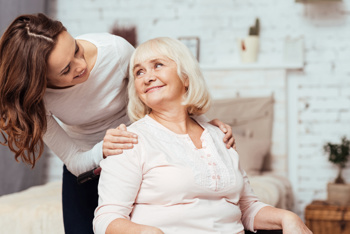
Causes of falls in old age
Causes of falls in old age, from the most frequent to the least frequent, include a history of previous falls, balance impairment, muscle loss, visual problems, taking more than four medications, gait disorders, depression, orthostasis, being over 80 years old, incontinence, cognitive difficulties, arthritis, diabetes, and pain.
The more potential causes of falls, the greater the risk of falling. The risk starts at 8% with no identifiable causes, rising to 78% with four potential causes. Medications that can cause falls include antihypertensives, antipsychotics, sedatives, antidepressants, and nonsteroidal anti-inflammatory drugs.
Falls are the most common type of accidents for people aged 65 and over and are the most common cause of hospitalisation in this age group. Roughly 10% of falls result in serious injuries, including hip fractures, other fractures, and traumatic brain injury. Injuries from falls can increase mortality risk.
Pathophysiological causes of falls
Various physiological disorders will contribute to falls risk:
- Sarcopenia: The progressive loss of muscle and strength with age. Can be accelerated by a lower intake of food, a long hospital stay, or a protracted illness.
- Cognitive impairment: Often found in older people especially in those suffering from mood swings, pain, or chronic illness.
- Postprandial hypotension: A sudden drop in blood pressure after a meal. Usually due to a dysfunction of the nervous system or the declining function of the cardiovascular system.
- Obesity: Often accompanied by a decline in muscle mass, muscle quality, and muscle function, resulting in reduced balancing ability.
- Osteoporosis: Weakens bone strength, causes spine kyphosis and decreases postural control.
- Impaired diaphragm function: Decreased muscle thickness and movement restriction can lead to balance disorders.
Intrinsic causes of falls
Some people have specific characteristics that make them more vulnerable to falls.
- History of falls: Increases the risk of future falls.
- Advanced age: Older people have decreased reaction time making it harder to avoid falls.
- Medications: Medicines including benzodiazepines, digoxin, antiarrhythmics, diuretics, sedatives and psychotropics significantly increase falls risk. Taking more than four drugs can also create a risk.
- Solitude: Living alone can make falls more likely and the consequences more severe if there is no one to provide help. However home sensors programmed to trigger real-time alerts can keep people safe even when they are alone.
- Medical conditions: Diabetes, vascular diseases, arthritis, thyroid dysfunction, depression and chronic obstructive pulmonary disease can cause falls.
- Gait impairments: An abnormal walking pattern due to a decline in lower body strength, power and endurance means that a slip or trip can become a fall.
- Sedentary behaviour: An inactive lifestyle can lead to physical deterioration and increase falls risk. Technology enabled care offers a solution through using technology to increase independence and improve quality of life.
- Fear of falling: People who have suffered a recent fall often develop a fear of falling. They react by limiting physical or social activity, leading to muscle weakness and loss of balance, making them more vulnerable to falls.
- Poor nutrition: Nutritional deficiencies can lead to weakness, dizziness, headaches and poor concentration, increasing the likelihood of falls.
- Cognitive disorders: Dementia, poor memory, and delirium are associated with an increased risk of falls. This can be mitigated by the use of specific technologies to keep a virtual eye on individuals with Alzheimer’s or other forms of dementia.
- Impaired vision: Glaucoma, cataracts, and other conditions that reduce contrast sensitivity and depth perception will increase falls risk.
- Foot problems: Foot pain, toe deformities, bunions, calluses, and nail abnormalities can affect balance, causing risk of falls.
Extrinsic Causes of falls
The danger from environmental hazards is a leading cause of falls in elderly people, accounting for 30-50% of falls in old age.
- Poor lighting: Makes it hard to see surroundings clearly. People may not spot potential fall hazards such as steps, changes in ground elevation, or objects on the floor.
- Slippery floors: Polished floor tiles create a slip hazard when wet or when people wear smooth soled shoes or socks.
- Uneven surfaces: Thresholds, thick carpets, rugs and floor clutter can cause people to trip and fall.
Whether the cause of falls is intrinsic or extrinsic, home sensors can help to keep people safe by detecting both anomalies in behaviour and environmental hazards like smoke or high temperature.

Causes of falling backwards in the elderly
Falling backwards in the elderly is a result of backward disequilibrium (BD), a postural disorder which causes people to stand with their centre of mass behind them. BD can be caused by a range of conditions including brain lesions, strokes, confinement to bed, depression, or an imbalance in the ankle muscles.
People with BD often find themselves trapped in a vicious cycle of falls. Falls can cause trauma, particularly hip fractures or subdural hematomas. The trauma has psychological consequences such as a fear of standing, walking, and falling. This in turn leads to social consequences including the loss of autonomy, institutionalisation, and becoming bedridden. The decline in physical activity causes reduced muscle mass, increasing the person’s likelihood of falling.
Causes of recurrent falls in elderly persons
Cardiovascular and neurological diseases are a significant cause of recurrent falls in elderly persons, according to a study of elderly emergency department patients. Use of selective serotonin reuptake inhibitors (SSRIs) and benzodiazepines is also a statistically significant factor in suffering frequent falls.
A person's sex, educational attainment, monthly income and living environment does not significantly increase the risk of multiple falls. However, persons aged 80 years and above are more likely to suffer multiple falls than persons below 80 years old.
Understanding the causes of falls in the elderly
Understanding the causes of falls is the first step in keeping elderly people safe from falling.
Technology enabled care (TEC) can be used to identify potential causes of falls, allowing carers to support up to 9 times more vulnerable people than before.
At Access we have been creating technology solutions for care providers for more than 30 years. We serve over 6,000 care homes and over 4,500 community agencies.
Our technology enabled care (TEC) solutions include:
- Home sensors identifying potential causes of falls. For example, people moving less can be a sign of inactivity, and people turning on the kettle less can be a sign of dehydration.
- Personal alarms wired to send alerts to a chosen contact, offering a virtual safety net for elderly people at risk of falls.
- Access Device Management Platform allowing carers to gain insight to the behaviours of people in their care to decrease the likelihood of falls occurring, or identify potential reasons behind frequent falls.
By identifying potential causes of falls at an early stage, proactive action can be taken to keep elderly people safe from harm.
To find out about the technology enabled care (TEC) we offer at Access, contact us here to discuss your needs or to book a demo.

